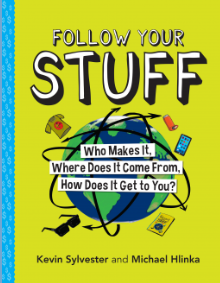Nonfiction | 9-15

In our consumer society, it can be a challenge to get a handle on the true price of things we want to buy, and why sometimes, it’s better to pay a little more. That’s so true in my small town where local businesses can struggle to keep prices competitive against cities’ big box stores and online distributors. To help children grasp these concepts, the Canadian creators of Follow Your Money have turned their attention to the production and distribution of five things of interest to kids: a t-shirt with a band logo, a cellphone, eyeglasses, a medical puffer, and the book itself (including the e-edition). Using colourful illustrations, factboxes, topical questions, charts and accessible text, they take the reader through the entire production process.
The book begins with a brief overview of how the global economy works, followed by a chapter on each of the items covered. For the t-shirt, readers learn about the farmer who grew the cotton and all the expenses she bears, along with the money earned (38 cents) for the amount of cotton needed for the t-shirt. We then follow the cost of the t-shirt through every step until it finally lands in the buyer’s hands. Through this the authors explain concepts like relative wages, markup, royalties. They also address topics like fair trade, copyright, and sweatshops, and ask readers to decide if they would be ready to pay a bit more to give workers a fair shake for their labour. I like this approach – giving young readers a chance to consider ethics as part of their buying process. The layout gives readers lots of places to dip in and enter the text, and Hlinka’s illustrations show a diverse cast of consumers and workers along the way. The book stops once the item is in the consumer’s hands – perhaps a future title could examine the problems that result from overconsumption. It’s a slim book at about 100 pages, and includes a two-page index, and two pages of references as well as suggestions for further reading online. My thanks to Annick Press for the advance reading copy provided digitally through NetGalley in exchange for my honest review.
More discussion and reviews of this title: https://www.goodreads.com/book/show/41005590
.
.
.
.
.
